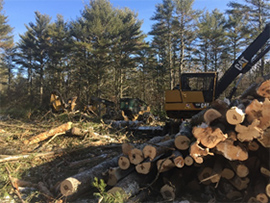Are We Playing Musical Chairs with Logging Capacity (And If We Are, What Happens?)

I got a call from a logger a few mornings ago, and the conversation has stuck with me. This logger – a larger contractor with multiple crews, millions invested in equipment, and a great reputation with landowners – was concerned about where the next generation of employees will come from. Of course, that’s not news – we know that workforce issues are a growing challenge for loggers, truckers, and mills.
What caught me off-guard is when he told me he had run the numbers, and it was much more beneficial to his business to go out and use cash to entice an employee from another logging crew than bring someone on and provide them on-the-job training. The productivity lost while someone learns to safely and efficiently operate logging equipment is a cost to the logger, and it can be quantified. So can the cost of looking at another company’s employees and paying to move them onto your crew. I didn’t ask the logger to back this up with data, but I know him well enough to know that he knows his numbers, probably better than most of his peers.
What this tells me is that if he and his peers act rationally, they are playing a game of musical chairs with logging capacity, where every time someone leaves the industry there are just fewer loggers. What’s rational in the short-term can be devastating in the long-term, and it’s easy to see how this leads to a severe lack of logging capacity.
At the same time, while it’s against the logger’s short-term interest to hire and train a new employee, it is clearly in the forest industry’s long-term interest for him to do so. Both the landowners he harvests for and the mills that he supplies need a stable, maybe even growing workforce to provide a sustainable supply of wood for decades to come.
I’ve mentioned this dilemma to a few folks, who have all told me some version of “don’t worry, the market will work this out.” I’m trained as an economist and I couldn’t agree more – the market will work this out.
However, I think most folks think that means that as logging capacity gets constrained logging revenues will rise; loggers will have more revenue and be able to hire and train new employees. If you were paying attention above, you’ll know that rising revenues might make the problem worse – the loss of productivity from a new employee becomes a bigger problem, not a smaller one.
There are many ways that the market can “solve” this issue, but they may not be ones we like. Not enough loggers, mills running out of wood and landowners unable to get a harvesting crew are all possible solutions that a well-functioning market could bring. Functioning markets can have all sorts of outcomes, and assuming that it’s the one you want is always risky.
I don’t know the solution to the “it’s a better financial move to hire an employee away from another logging crew than to hire and train a new employee”, but I know it’s a problem. And if we don’t think about it, and talk about it, it’s a problem that will get worse. I don’t pretend to have a solution, but would love to hear your thoughts. I also know this is an issue in the Northeast, but don’t know if other parts of the country are seeing the same dynamic.
If you are part of – or rely upon – the forest industry supply chain and have some ideas, I would appreciate hearing from you at [email protected]. I’ll take some of the comments I receive and publish them in a future blog (I won’t post your name or company, but will say what part of the supply chain and where you are located; e.g., “Landowner, Lakes States”). Thinking about this problem (if it is a problem) and solutions (if any exist) is probably the next step, and I look forward to that dialogue.


